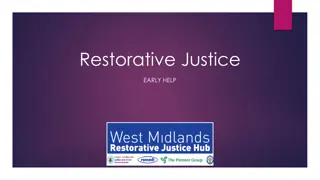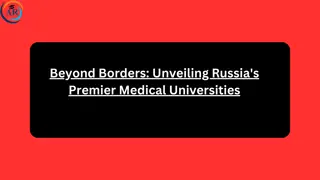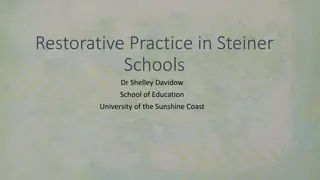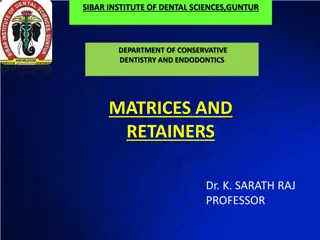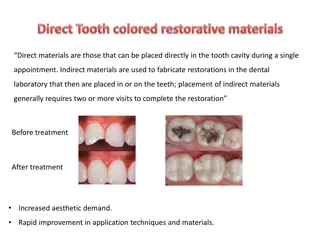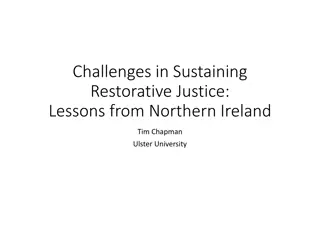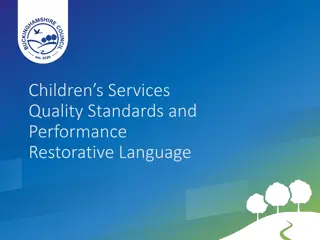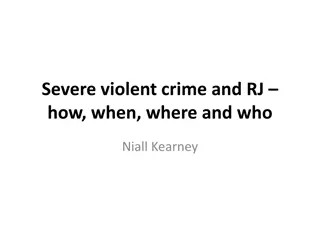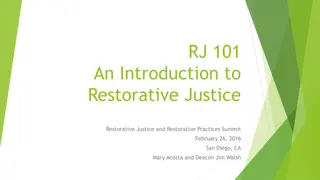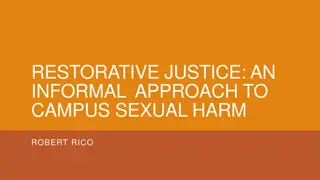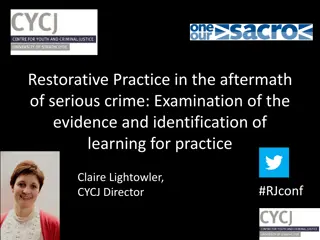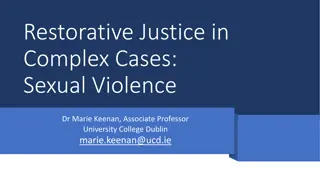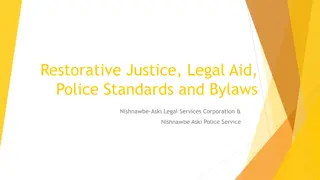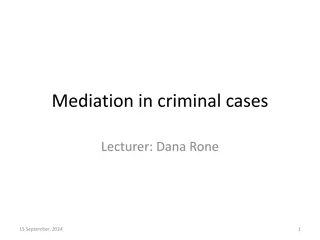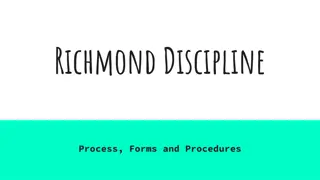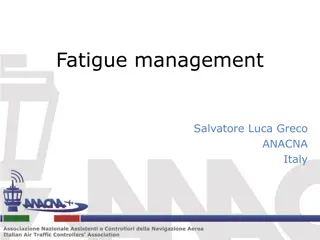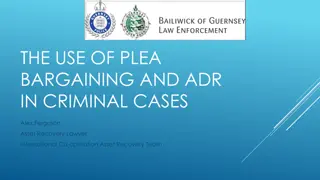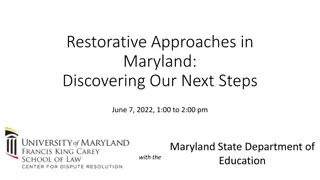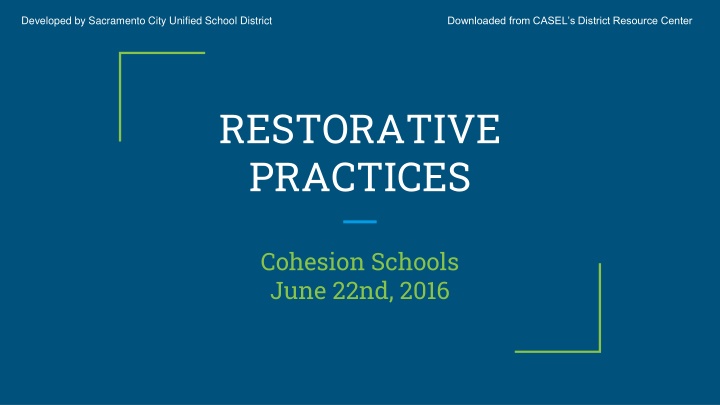
Effective Restorative Practices in Education
Explore resources developed by Sacramento City Unified School District in collaboration with CASEL's District Resource Center, focusing on implementing restorative practices for cohesion in schools. Reflect on practitioner styles, social discipline windows, and more to enhance your approach in educational settings.
Download Presentation

Please find below an Image/Link to download the presentation.
The content on the website is provided AS IS for your information and personal use only. It may not be sold, licensed, or shared on other websites without obtaining consent from the author. If you encounter any issues during the download, it is possible that the publisher has removed the file from their server.
You are allowed to download the files provided on this website for personal or commercial use, subject to the condition that they are used lawfully. All files are the property of their respective owners.
The content on the website is provided AS IS for your information and personal use only. It may not be sold, licensed, or shared on other websites without obtaining consent from the author.
E N D
Presentation Transcript
Developed by Sacramento City Unified School District Downloaded from CASEL s District Resource Center RESTORATIVE PRACTICES Cohesion Schools June 22nd, 2016
Developed by Sacramento City Unified School District Downloaded from CASEL s District Resource Center Introduction Circle What s your name? Where do you work? Where is your favorite vacation spot?
Developed by Sacramento City Unified School District Downloaded from CASEL s District Resource Center SFUSD Video Reflection Introduction to Restorative Practices THINK: What question or challenge came to mind in terms of expanding restorative practices for yourself or at your site? Pair up with a neighbor and discuss.
Developed by Sacramento City Unified School District Downloaded from CASEL s District Resource Center Social Discipline Window Control Support
Developed by Sacramento City Unified School District Downloaded from CASEL s District Resource Center
Developed by Sacramento City Unified School District Downloaded from CASEL s District Resource Center Social Discipline Window Activity Social Discipline Window Activity In small groups of 3 or 4: Talk about a time when someone in a position of authority treated you restoratively What was that experience like for you? What was it specifically that made it restorative? What can YOU do to be more purposeful in your practice?
Developed by Sacramento City Unified School District Downloaded from CASEL s District Resource Center Practitioner Styles Practitioner Styles In which box would you be operating if you said each of the following to a student/young person: Sit down and shut up. You really only have to do it if you want to. I don t care what you do, sort it out yourself. You are aware of the expectations in this class. How can I support you in reaching them?
Developed by Sacramento City Unified School District Downloaded from CASEL s District Resource Center Practitioner Styles Activity Practitioner Styles Activity In your groups, identify the behaviors you would likely observe if a practitioner s style was predominately: Punitive Permissive Neglectful Restorative What would the likely OUTCOMES be for a young person?
Developed by Sacramento City Unified School District Downloaded from CASEL s District Resource Center Punitive Practitioner Style Punitive Practitioner Style Low Support/High Control Likely Outcomes Punitive and often uses loud, angry voice Ordered classroom/setting Anxious resentful students Notices inappropriate behavior more than appropriate Short term compliance but rarely lasting behavior change Has high standards High Teacher/practitioner stress Negative classroom atmosphere
Developed by Sacramento City Unified School District Downloaded from CASEL s District Resource Center Practitioner Styles Activity Practitioner Styles Activity In your groups, identify the behaviors you would likely observe if a practitioner s style was predominately: Punitive Permissive Neglectful Restorative What would the likely OUTCOMES be for a young person?
Developed by Sacramento City Unified School District Downloaded from CASEL s District Resource Center Permissive Practitioner Style Permissive Practitioner Style High Support/Low Control Likely Outcomes Warm and supportive Students feel liked and supported Doesn t set limits Chaotic out of control classroom Focus on effort and de-emphasis of quality Students do not feel secure in the teacher s capacity to manage Inappropriate behavior handled through ignoring or handled with weak reprimands or pleading Poor work quality Students feel anxious/uncertain High teacher stress
Developed by Sacramento City Unified School District Downloaded from CASEL s District Resource Center Neglectful Practitioner Style Neglectful Practitioner Style Low Support/Low Control Likely Outcomes Teacher remains at desk and students do not feel cared for May miss warning signs of academic or behavioral difficulties in students Teacher does not appear concerned about quality of students work Students may withdraw and feel worthless May result from teacher stress, burn- out, depression or physical illness Increased acting out in order to get teacher s attention or because no sense or order or control in classroom May be lack of skill in how to be warm while demanding Limited meaningful learning taking place
Developed by Sacramento City Unified School District Downloaded from CASEL s District Resource Center Restorative Practitioner Style Restorative Practitioner Style High Support/High Control Likely Outcomes Positive kind and supportive relationships Positive atmosphere Effective discipline plan and orderly classroom High Quality work output Positive Relationships Sense of hope/optimism Students feel sense of safety and competence High level of work quality High job satisfaction
Developed by Sacramento City Unified School District Downloaded from CASEL s District Resource Center Break! Please be back by 11:00.
Developed by Sacramento City Unified School District Downloaded from CASEL s District Resource Center Fair Process: The Central Idea Fair Process: The Central Idea ...individuals are most likely to trust and cooperate freely with systems -whether they themselves win or lose by those systems -when fair process is observed. (W. Chan Kim & Renee Mauborgne, Harvard Business Review, January 2003)
Developed by Sacramento City Unified School District Downloaded from CASEL s District Resource Center The Three Principles of Fair Process The Three Principles of Fair Process Engagement Explanation Expectation Clarity (W. Chan Kim & Renee Mauborgne, Harvard Business Review, January 2003)
Developed by Sacramento City Unified School District Downloaded from CASEL s District Resource Center What Fair Process Isn t What Fair Process Isn t Decisions by consensus Democracy in your system Does not set out to win people s support through compromises that accommodate every individual s opinions, needs, or interest Leaders forfeiting their responsibility to make decisions, establish policies and procedures
Developed by Sacramento City Unified School District Downloaded from CASEL s District Resource Center What Fair Process Achieves What Fair Process Achieves Fair process builds trust and commitment, which Produces voluntary co-operation, which Drives performance, which Leads individuals to go beyond the call of duty Through sharing their knowledge, experiences and creativity
Developed by Sacramento City Unified School District Downloaded from CASEL s District Resource Center Compass of Shame WITHDRAWAL Isolating oneself Running & hiding ATTACK OTHERS Turning the tables Blaming the victim Lashing out verbally or physically ATTACK SELF Self put down Masochism AVOIDANCE Denial Abusing drugs & alcohol Distraction through thrill seeking
Developed by Sacramento City Unified School District Downloaded from CASEL s District Resource Center Shame Activity In triads share which pole on the compass of shame you are drawn to when you experience a shame moment. You do not have to share the story.
Developed by Sacramento City Unified School District Downloaded from CASEL s District Resource Center You can respond to others experiencing You can respond to others experiencing shame by: shame by: Listening to what they have to say. Being present with them, without trying to problem solve. Reflecting on what has caused the shame. Acknowledging their feelings. Encouraging them to talk about their experience.
Developed by Sacramento City Unified School District Downloaded from CASEL s District Resource Center John Braithwaite s Hypothesis While: Separating the deed from the doer Restorative Practices allow: The act (unacceptable behavior) to be rejected because they failed to meet expectations or standards. Acknowledging the intrinsic worth of the person and their potential contribution to society.
Developed by Sacramento City Unified School District Downloaded from CASEL s District Resource Center Stigmatizing vs. Reintegrative Shame Stigmatizing Reintegrative Shame Pushes the offender out of the community and labels them. The offender is now a bad person who committed a crime or harm. This label may follow them their whole lives. Since the offender is pushed out of the community it may encourage their participation in further harmful behaviors. Expresses disapproval but does not push the offender out of the community. This type of shame rejects the act but not the person and allows for the person to be reintegrated back into the community.
Developed by Sacramento City Unified School District Downloaded from CASEL s District Resource Center Lunch Please Be Back By 12:30! Be Prompt!!
Developed by Sacramento City Unified School District Downloaded from CASEL s District Resource Center Energizer...
Developed by Sacramento City Unified School District Downloaded from CASEL s District Resource Center Restorative Practices Continuum Restorative Practices Continuum
Developed by Sacramento City Unified School District Downloaded from CASEL s District Resource Center Affective Statements: Affective Statements: are feeling statements about the impact of another person s behavior on us; they describe how WE feel in relation to another s behavior. Set Boundaries Provide Feedback Teach Empathy
Developed by Sacramento City Unified School District Downloaded from CASEL s District Resource Center
Developed by Sacramento City Unified School District Downloaded from CASEL s District Resource Center Affective Statements: Activity One Affective Statements: Activity One Complete the following statements: I feel glad when... I feel mad when... I feel sad when... I feel scared when... I feel...when...
Developed by Sacramento City Unified School District Downloaded from CASEL s District Resource Center Typical Responses Affective Statements Stop teasing Ruben. It makes me uncomfortable when I hear you teasing Ruben. Talking during class is inappropriate. I am frustrated that you aren t listening to me. You shouldn t do that. I feel sad when you say something like that to Juan. Sit down and be quiet. You need to quit fighting with him. I get angry when you talk and joke during my lessons.
Developed by Sacramento City Unified School District Downloaded from CASEL s District Resource Center Affective Statements: Activity Two Affective Statements: Activity Two Change each statement into an affective statement: Talking while I m talking is rude. For the third time, put away the phone. Sit down and stop talking. Why don t you ever do your homework? You need to start getting along with others. Pick your head up.
Developed by Sacramento City Unified School District Downloaded from CASEL s District Resource Center Check in! Think/Pair/Share with your partner: Why affective statements? What are the benefits of using affective statements in our classrooms and school communities?
Developed by Sacramento City Unified School District Downloaded from CASEL s District Resource Center Activity: Restorative Questions Activity: Restorative Questions - - Side Two Side Two Think about a time in your life when you were harmed. What did you think when you realized what had happened? What impact has this incident had on you and others? What has been the hardest thing for you? What do you think needs to happen to make things right?
Developed by Sacramento City Unified School District Downloaded from CASEL s District Resource Center Activity: Restorative Questions Activity: Restorative Questions - - Side One Side One Think about a time in your life when you harmed someone. What happened? What were you thinking at the time? What have you thought about since? Who has been affected by what you have done and in what way? What do you think you need to do to make things right?
Developed by Sacramento City Unified School District Downloaded from CASEL s District Resource Center Break! Be back in 10 minutes!
Developed by Sacramento City Unified School District Downloaded from CASEL s District Resource Center Energizer Circle
Developed by Sacramento City Unified School District Downloaded from CASEL s District Resource Center Why Circles? Why Circles? Equality Equality- -everyone literally has equal seating. Safety and trust Safety and trust-you can see everyone in the circle. Responsibility and Ownership Responsibility and Ownership-everyone plays a role. Teacher as member Teacher as member; reminds you to facilitate-rather than lecture. Builds connections Builds connections-everyone hears everyone else s response.
Developed by Sacramento City Unified School District Downloaded from CASEL s District Resource Center Circles Circles Non-Sequential Sequential May feel less controlled, but have benefits in many situations. Typically specific questions answered in order around the circle. They can be: highly structured, loosely structured, or unstructured. Talking Piece for added structure. There is no particular order of speaking. Participation expected, but not always required. (May Pass) Expectations for participation are more relaxed.
Developed by Sacramento City Unified School District Downloaded from CASEL s District Resource Center Secrets to Success Secrets to Success Clear topic and goal Set a positive tone Keep the focus Get some allies MAKE SURE participants understand why you are doing circles (explanation and expectation clarity), remembering it may be uncomfortable for them at first.
Developed by Sacramento City Unified School District Downloaded from CASEL s District Resource Center Introducing the Concept Explain reasoning/rationale Be upbeat Regard resistance as fear
Developed by Sacramento City Unified School District Downloaded from CASEL s District Resource Center Circle Scenarios Circle Scenarios In the Classroom: Staff or community: End of Quarter/Grading period Team Building Goal Setting Staff Development Vandalism/Theft Problem Solving In response to violence or tragedy Getting parents involved in community Field trip Truancy Excessive Tardies
Developed by Sacramento City Unified School District Downloaded from CASEL s District Resource Center Circle Scenarios Activity The facilitator will run a sequential go-around. Facilitator will guide the group into choosing 2-3 specific scenarios. After the scenarios are chosen, the group will have a non sequential discussion: How would you use circles to address this scenario? What kind of circle would you use? What questions would you ask to address the issue? Build the questions using the affective questions format of past, present, and future.
Developed by Sacramento City Unified School District Downloaded from CASEL s District Resource Center Closing Circle

